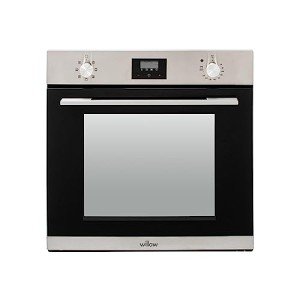Buzzwords De-Buzzed: 10 More Ways To Say Builtin Oven
페이지 정보

본문
The Comprehensive Guide to Built-In Ovens: Features, Benefits, and FAQs
Built-in ovens are a popular choice for contemporary cooking areas, providing flexibility, performance, and a sleek design that integrates perfectly into cabinets. This post will explore the various elements of built-in ovens, including their features, benefits, installation options, upkeep ideas, and answers to frequently asked questions.

What is a Built-In Oven?
A Built-in Oven (right here on www.bitsdujour.com) is created to be installed within kitchen cabinetry and is readily available in numerous configurations, such as single or double ovens. Unlike freestanding ovens, built-in designs provide a structured look and use more flexibility in kitchen style. They are available in electric, gas, and steam alternatives, catering to a series of cooking preferences.
Functions of Built-In Ovens
Built-in ovens are loaded with features that boost cooking experiences. Here are some of the most common features to consider:
| Feature | Description |
|---|---|
| Self-Cleaning | Numerous designs consist of a self-cleaning function that burns off residue at heats, simplifying maintenance. |
| Convection Cooking | This function uses a fan to distribute hot air, cooking food more uniformly and quickly. |
| Smart Technology | Some ovens come equipped with Wi-Fi connection, enabling users to manage the oven remotely via mobile phone. |
| Numerous Cooking Modes | Include choices such as baking, broiling, roasting, and air frying, offering flexibility for different dishes. |
| Temperature level Probe | Keeps track of the internal temperature of food, ensuring perfectly prepared meals whenever. |
| Smooth Design Options | Offered in different finishes (stainless steel, black, white) to match kitchen built in oven decor. |
Benefits of Built-In Ovens
The setup of a built-in oven brings various benefits to any kitchen:
- Space Efficiency: Built-in ovens optimize kitchen space, supplying a tidy and orderly look without sacrificing functionality.
- Improved Cooking Performance: With advanced features like convection cooking and precise temperature level controls, built-in ovens frequently outshine standard models.
- Design Flexibility: These ovens can be set up at eye level, permitting simple access without bending down, which can be particularly helpful for individuals with physical constraints.
- Improved Resale Value: A properly designed kitchen with high-quality built-bulit in oven appliances may interest prospective buyers, improving general property value.
- Personalization Options: built-in oven Many brand names provide personalized styles that fit the particular measurements and aesthetic of individual cooking areas.
Setup Options
When choosing a built-in oven, understanding the installation choices is crucial. Here are the most typical setups:
Single Built-In Oven: Ideal for smaller kitchens, these units provide sufficient space to prepare a range of meals simultaneously, ideal for everyday cooking.
Double Built-In Oven: best integrated oven uk suited for avid cooks and large households, double ovens allow for synchronised cooking at two various temperatures, suitable for meals that need varied cooking approaches.
Mix Steam and Oven: A hybrid service that combines the benefits of standard baking with steam cooking. This alternative is exceptional for maintaining wetness in foods, making it ideal for baking bread or roasting meats.
Maintenance Tips for Built-In Ovens
Maintaining a built-in oven is necessary for its longevity and optimum performance. Here are some useful maintenance tips:
Regular Cleaning: Use the self-cleaning function when necessary, and wipe down the outside and interior surfaces frequently to prevent grease accumulation.
Check the Seals: Inspect the oven door seals for any wear or damage to make sure appropriate insulation and cooking efficiency.
Temperature level Calibration: Occasionally evaluate the temperature accuracy using an oven thermometer, particularly if cooking times appear longer than typical.
Ventilation: Ensure adequate ventilation around the oven to avoid overheating, particularly for built-in models that might be surrounded by cabinetry.
Frequently Asked Questions About Built-In Ovens
1. Are built-in ovens more expensive than freestanding models?Yes, built-in ovens tend to be more pricey due to their style, installation requirements, and extra functions. However, their advantages can justify the cost in the long run.

2. Can you install a built-in oven yourself?While some helpful people may try to install a built-in oven, it is advised to work with a professional to guarantee proper setup, ventilation, and security standards.
3. What is the average lifespan of a built-in oven?The common life expectancy of a built-in oven is around 10 to 15 years, depending upon use and maintenance. Routine care can assist extend its longevity.
4. Are built-in ovens energy effective?Numerous modern-day built-in ovens are designed with energy effectiveness in mind, incorporating features like insulation and accurate temperature controls that might lower energy intake compared to older models.
5. Can a built-in oven be fixed if it breaks?Yes, built-in ovens can often be fixed. It is a good idea to contact a certified professional for medical diagnoses and repair work to guarantee security and compliance with warranty agreements.
Built-in ovens are an excellent addition to any contemporary kitchen, supplying a combination of style, functionality, and advanced cooking functions. With the ideal knowledge about their features, benefits, and maintenance, house owners can make educated choices to boost their culinary experiences. As kitchen design patterns continue to evolve, the built-in oven stays a staple for those seeking to blend visual appeals with performance in their cooking spaces.
- 이전글The 10 Most Scariest Things About Combi Microwave Oven Integrated 25.05.19
- 다음글Sex On Kik Modifications 5 Actionable Tips 25.05.19
댓글목록
등록된 댓글이 없습니다.



